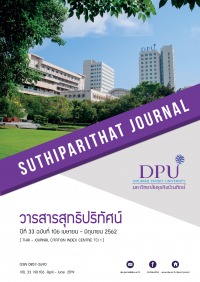ปัจจัยส่วนประสมทางการตลาดที่มีอิทธิพลต่อความพึงพอใจในการซื้อของฝากของชาวญี่ปุ่นที่เดินทางมาประเทศไทย
คำสำคัญ:
ความพึงพอใจ, ของฝาก, นักท่องเที่ยวชาวญี่ปุ่น, ส่วนประสมทางการตลาด (4Ps)บทคัดย่อ
ชาวญี่ปุ่นเป็นชนชาติหนึ่งที่ให้ความสำคัญกับการซื้อของฝากในประเทศที่ไปเยือน สำหรับประเทศไทย นักท่องเที่ยวชาวญี่ปุ่นถูกจัดว่าเป็นกลุ่มตลาดที่สำคัญรองจากจีนและมาเลเซีย ทั้งยังมีศักยภาพสูงเรื่องการจับจ่ายใช้สอย ทำให้นักท่องเที่ยวชาวญี่ปุ่นเป็นกลุ่มตลาดที่น่าสนใจสำหรับธุรกิจของฝากในประเทศไทย การศึกษาวิจัยนี้จึงมีวัตถุประสงค์เพื่อศึกษาปัจจัยส่วนประสมทางการตลาดที่มีอิทธิพลต่อความพึงพอใจในการซื้อของฝากโดยนักท่องเที่ยวชาวญี่ปุ่นที่เดินทางมาเยือนประเทศไทย โดยการวิเคราะห์ถดถอยเชิงซ้อน (Linear Regression) ของกลุ่มปัจจัยส่วนประสมทางการตลาด (4Ps) ที่ได้จากการวิเคราะห์ปัจจัย (Factor Analysis) ข้อมูลที่นำมาวิเคราะห์ได้มาจากการเก็บรวบรวมแบบสอบถามจากนักท่องเที่ยวชาวญี่ปุ่นทั้งสิ้น 413 ชุด ผลการทดสอบสมมติฐานพบว่า ปัจจัยส่วนประสมทางการตลาดด้านผลิตภัณฑ์ (Product) และการส่งเสริมการขาย (Promotion) มีอิทธิพลต่อความพึงพอใจในการเลือกซื้อของฝากของนักท่องเที่ยวชาวญี่ปุ่นมากที่สุด จากผลการวิจัยจึงนำมาซึ่งข้อแนะนำสำหรับผู้ประกอบการและหน่วยงานที่เกี่ยวข้อง เพื่อนำไปพัฒนาสินค้าของฝากและการให้บริการที่เกี่ยวข้องกับธุรกิจของฝากในประเทศไทยต่อไป
เอกสารอ้างอิง
กรมการท่องเที่ยว. (2558). International tourist arrivals to Thailand [online]. สืบค้นเมื่อ 9 ตุลาคม 2561, จาก https://www.mots.go.th
กรมการท่องเที่ยว. (2559). Average expenditure of international tourist arrivals (By Expenditure Item). [online]. สืบค้นเมื่อ 12 ธันวาคม 2561, จาก https://www.mots.go.th
กรมการท่องเที่ยว. (2561). Tourism receipts from international tourist arrivals 2017. [online]. สืบค้นเมื่อ 20 มกราคม 2562, จาก https://www.mots.go.th
Ashkenazi, M., & Jacob, J. (2001). The essence of Japanese cuisine: An essay on food and culture. Philadelphia: University of Pennsylvania Press.
Anderson, L. F., & Littrell, M. A. (1996). Group profiles of women as tourists and purchasers of souvenirs. Family and Consumer Sciences Research Journal, 25(1), 28-56. DOI: 10.1177/1077727x960251002
Aoyama Happy Kenkyusho (Asashi Group Holdings). (2017). 旅行や出張時にお土産を買いますか?Retrieved January 11, 2018, from https://www.asahigroup-holdings.com/company/research/hapiken.
Belsley, D.A., Kuh, E., & Welsch, R.E. (1980). Regression diagnostic: Identifying influential data and sources of collinearity. New York: Wiley.
Blackwell, R. D., Miniard, P. W., & Engel, J. F. (2006). Consumer behavior. Mason, OH: Thomson/South-Western.
Callans, J. (1998). Craving for edible souvenirs. Japan Quarterly, 45(3), 67-76.
Castellanos-Verdugo, M., Oviedo-Garcia, M. Á., & Vega-Vázquez, M. (2017). Souvenir shopping satisfaction: antecedents and consequences. European Journal of Tourism Research, 17, 191–205. Retrieved from https://search.ebscohost.com/login.aspx?direct=true&db=hjh&AN=125672864&site=ehost-live
Chaiklin, M. (2017). Mediated by gifts: Politics and society in Japan, 1350-1850. Leiden: Brill.
Glass, A. (2008). Crests on cotton: ‘‘Souvenir’’ T-Shirts and the materiality of remembrance among the Kwakwaka’wakw of British Columbia. Museum Anthropology, 31(1), 1-17.
Gordon, B. (1986). The souvenir: Messenger of the extraordinary. The Journal of Popular Culture, 20(3), 135-146. DOI: 10.1111/j.0022-3840.1986.2003_135.x
Håkansson, H., & Waluszewski, A. (2005). Developing a new understanding of markets: reinterpreting the 4Ps. Journal of Business & Industrial Marketing, 20(3), 110-117. DOI: 10.1108/08858620510592722
Hendry, J. (1995). Wrapping culture: Politeness, presentation, and power in Japan and other societies [Google Books version]. Retrieved from https://books.google.com.au/books?id=7EMD2y_ALkQC
Holder, J. (1989). Tourism and the future of caribbean handicraft. Tourism management, 10(4), 310-314. DOI: 10.1016/0261-5177(89)90009-5
Huttasin, N. (2011). Perceived social impacts of tourism by residents in the OTOP tourism village, Thailand. Asia Pacific Journal of Tourism research, 13(2), 175-191.
Kanzaki, N. (1997). おみやげ―贈答と旅の日本文化 [in Japanese]. Tokyo: Seikyusha.
Kim, S., & Littrell, M. A. (1999). Predicting souvenir purchase intentions. Journal of Travel Research, 38(2), 153-162. DOI: 10.1177/004728759903800208
Kim, S., & Littrell, M. A. (2001). Souvenir buying intentions for self versus others. Annals of Tourism Research, 28(3), 638-657. DOI: 10.1016/s0160-7383(00)00064-5
Kim, S., Timothy, D., & Hwang, J. (2011). Understanding Japanese tourists’ shopping preferences using the Decision Tree Analysis method. Tourism Management, 32(3), 544-554.
Kotler, P., & Armstrong, G. (1996). Principles of marketing. Singapore: Prentice Hall.
Jang, S., Bai, B., Hong, G., & O’Leary, J. (2004). Understanding travel expenditure patterns: a study of Japanese pleasure travelers to the United States by income level. Tourism Management, 25(3), 331-341.
JTB Corporation. (2014). 海外ショッピングレポート (2014) [in Japanese]. Retrieved from https://www.tourism.jp/tourism-database/survey/2014/11/shopping-oversea-2014/
JTB Tourism Research & Consulting Co. (2019). Statistics of Japan residents’/Japanese visits abroad (Historical figures/by Country). Retrieved January 18, 2019 from https://www.tourism.jp
Littrell, M. A., Anderson, L. F., & Brown, P. J. (1993). What makes a craft souvenir authentic?. Annals of tourism research, 20, 197-215
Maruyama, K. (2008). 富山県における地域ブランド創造に関する実証的研究: 顧客を富山県に 誘発するお土産品からのアプローチ [in Japanese]. Journal of Toyama College 43(1), 33-47, 2008
McCarthy, J. E. (1960). Basic marketing. A managerial approach. Retrieved from https://babel.hathitrust.org
Nobuo, T. (1988). Japanese abroad: Armed with slippers and soy sauce. Japan Quarterly, 35 (October-December), 432-436.
Ohashi, A. (2003). 信州限定土産商品の考察 [in Japanese]. 観光文化研究所所報 創刊号, 11-31.
Onoda T., Koshizuka T., & Ohsawa Y. (2007). 地名別お土産販売種類数と重力モデル [in Japanese]. 日本オペレーションズ・リサーチ学会秋季研究発表会アブストラクト集2007, 62-63.
Park, M. K. (2000). Social and cultural factors influencing tourists’ souvenir purchasing behavior: A comparative study on Japanese ‘‘Omiyage’’ and Korean ‘‘Sunmul’. Journal of Travel and Tourism Marketing, 9(1/2), 81–91.
Pigliasco, G. C. (2005). Lost in translation: from Omiyage to Souvenir: Beyond aesthetics of the Japanese office ladies' gaze in Hawaii. Journal of Material Culture, 10, 177-196.
Potts, R. (2018). Souvenir. USA: Bloomsbury Publishing.
Rupp, K. (2003). Gift-giving in Japan: Cash, connections, cosmologies. Stanford: Stanford University Press.
Rosenbaum, M., & Spears, D. (2005). Who buys that? Who does what? Analysis of cross-cultural consumption behaviours among tourists in Hawaii. Journal of Vacation Marketing, 11, 235-247.
Shimohata, M., Miki, H., Hosono, N., & Tachibana, S. (2012). 観光地での土産購入における購入率と行動指標の分析 [in Japanese]. Journal of Japan Industrial Management Association, 63(3), 173-181.
Spears, D., & Rosenbaum, M. (2006). An exploration of spending behaviors among japanese tourists. Journal of Travel Research, 44(4), 467-473.
Spears, D., & Rosenbaum, M. (2012). The packaged tourist: A Japanese and american perspective. Tourismos: An International Multidisciplinary Journal of Tourism, 7, 19-40.
Suzuki, Y. (2013). おみやげと鉄道: 名物で語る日本近代史 [in Japanese]. 講談社, 20113.
Swanson, K. S. (2004). Tourists' and retailers' perceptions of souvenirs. Journal of Vacation Marketing, 10(4), 363-377.
Tsujimoto, N., Taguchi, N., & Araki, N. (2013). 贈与動機が消費者の購買行動にあたえる影響─熊本県における観光土産の実証研究─[in Japanese]. St. Andrew's University economic and business review, 55(1/2), 225-255.
Torabian, P., & Arai, S. M. (2016). Tourist perceptions of souvenir authenticity: an exploration of selective tourist blogs. Current Issues in Tourism, 19(7), 697–712. https://doi.org/10.1080/13683500.2013.820259
Wilkins, H. (2010). Souvenirs: What and why we buy. Journal of Travel Research, 50, 239. DOI: 10.1177/0047287510362782
Witkowski, T., & Yamamoto, Y. (1991). Omiyage gift purchasing by japanese travelers in the U.S. Advances in Consumer Research, 18, 123-128.
Zineldin, M., & Philipson, S. (2007). Kotler and Borden are not dead: myth of relationship marketing and truth of the 4Ps. Journal of Consumer Marketing, 24(4), 229-241. DOI: 10.1108/07363760710756011
ดาวน์โหลด
เผยแพร่แล้ว
รูปแบบการอ้างอิง
ฉบับ
ประเภทบทความ
สัญญาอนุญาต
เนื้อหาและข้อมูลในบทความที่ลงตีพิมพ์ในวารสารสุทธิปริทัศน์ ถือเป็นข้อคิดเห็นและความรับผิดชอบของผู้เขียนบทความโดยตรงซึ่งกองบรรณาธิการวารสาร ไม่จำเป็นต้องเห็นด้วย หรือร่วมรับผิดชอบใด ๆ
บทความ ข้อมูล เนื้อหา รูปภาพ ฯลฯ ที่ได้รับการตีพิมพ์ในวารสารสุทธิปริทัศน์ ถือเป็นลิขสิทธิ์ของวารสารสุทธิปริทัศน์หากบุคคลหรือหน่วยงานใดต้องการนำทั้งหมดหรือส่วนหนึ่งส่วนใดไปเผยแพร่ต่อหรือเพื่อกระทำการใด ๆ จะต้องได้รับอนุญาตเป็นลายลักษณ์อักษรจากวารสารสุทธิปริทัศน์ก่อนเท่านั้น







